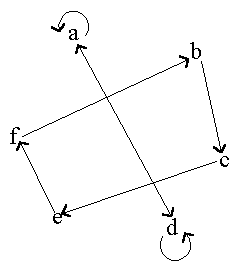
1) P belongs to the set A \B
2) Q belongs to the set B \A
3) R belongs to the complement of (A \B) È(B \A)
(S) (A Ç B) \ C = {P}
becomes true.
1. You may test each item by using the dynamical "electric circuit" figure.
2. After having clicked all choices in the table rows you can check whether all your choices are correct (Evaluate-button).
E = { (a, a), (a, c), (a, e), (b, b), (b, f), (c, a), (c, c),(c, e), (d, d), (e, a), (e, c), (e, e), (f, b), (f, f) }Drag the elements to the equivalence classes induced by E.

|